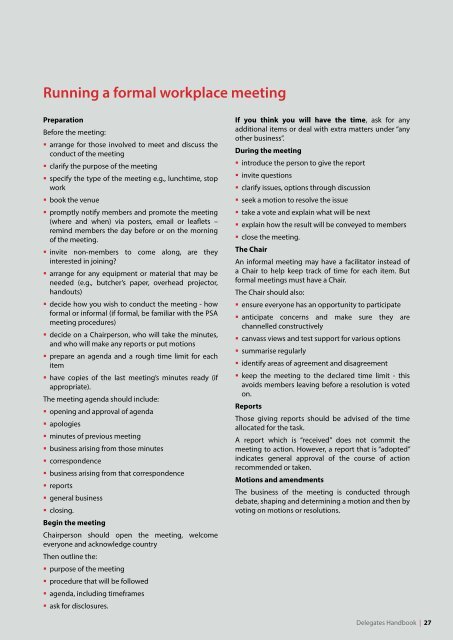Delegates Handbook
delegates_handbook
delegates_handbook
You also want an ePaper? Increase the reach of your titles
YUMPU automatically turns print PDFs into web optimized ePapers that Google loves.
Running a formal workplace meeting<br />
Preparation<br />
Before the meeting:<br />
• arrange for those involved to meet and discuss the<br />
conduct of the meeting<br />
• clarify the purpose of the meeting<br />
• specify the type of the meeting e.g., lunchtime, stop<br />
work<br />
• book the venue<br />
• promptly notify members and promote the meeting<br />
(where and when) via posters, email or leaflets –<br />
remind members the day before or on the morning<br />
of the meeting.<br />
• invite non-members to come along, are they<br />
interested in joining?<br />
• arrange for any equipment or material that may be<br />
needed (e.g., butcher’s paper, overhead projector,<br />
handouts)<br />
• decide how you wish to conduct the meeting - how<br />
formal or informal (if formal, be familiar with the PSA<br />
meeting procedures)<br />
• decide on a Chairperson, who will take the minutes,<br />
and who will make any reports or put motions<br />
• prepare an agenda and a rough time limit for each<br />
item<br />
• have copies of the last meeting’s minutes ready (if<br />
appropriate).<br />
The meeting agenda should include:<br />
• opening and approval of agenda<br />
• apologies<br />
• minutes of previous meeting<br />
• business arising from those minutes<br />
• correspondence<br />
• business arising from that correspondence<br />
• reports<br />
• general business<br />
• closing.<br />
Begin the meeting<br />
Chairperson should open the meeting, welcome<br />
everyone and acknowledge country<br />
Then outline the:<br />
• purpose of the meeting<br />
• procedure that will be followed<br />
• agenda, including timeframes<br />
• ask for disclosures.<br />
If you think you will have the time, ask for any<br />
additional items or deal with extra matters under “any<br />
other business”.<br />
During the meeting<br />
• introduce the person to give the report<br />
• invite questions<br />
• clarify issues, options through discussion<br />
• seek a motion to resolve the issue<br />
• take a vote and explain what will be next<br />
• explain how the result will be conveyed to members<br />
• close the meeting.<br />
The Chair<br />
An informal meeting may have a facilitator instead of<br />
a Chair to help keep track of time for each item. But<br />
formal meetings must have a Chair.<br />
The Chair should also:<br />
• ensure everyone has an opportunity to participate<br />
• anticipate concerns and make sure they are<br />
channelled constructively<br />
• canvass views and test support for various options<br />
• summarise regularly<br />
• identify areas of agreement and disagreement<br />
• keep the meeting to the declared time limit - this<br />
avoids members leaving before a resolution is voted<br />
on.<br />
Reports<br />
Those giving reports should be advised of the time<br />
allocated for the task.<br />
A report which is “received” does not commit the<br />
meeting to action. However, a report that is “adopted”<br />
indicates general approval of the course of action<br />
recommended or taken.<br />
Motions and amendments<br />
The business of the meeting is conducted through<br />
debate, shaping and determining a motion and then by<br />
voting on motions or resolutions.<br />
<strong>Delegates</strong> <strong>Handbook</strong> | 27


